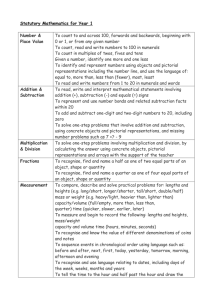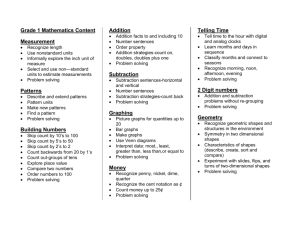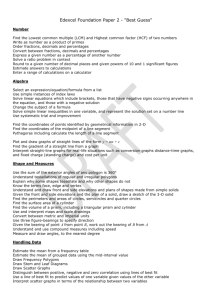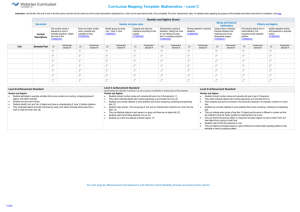Grade 2
advertisement
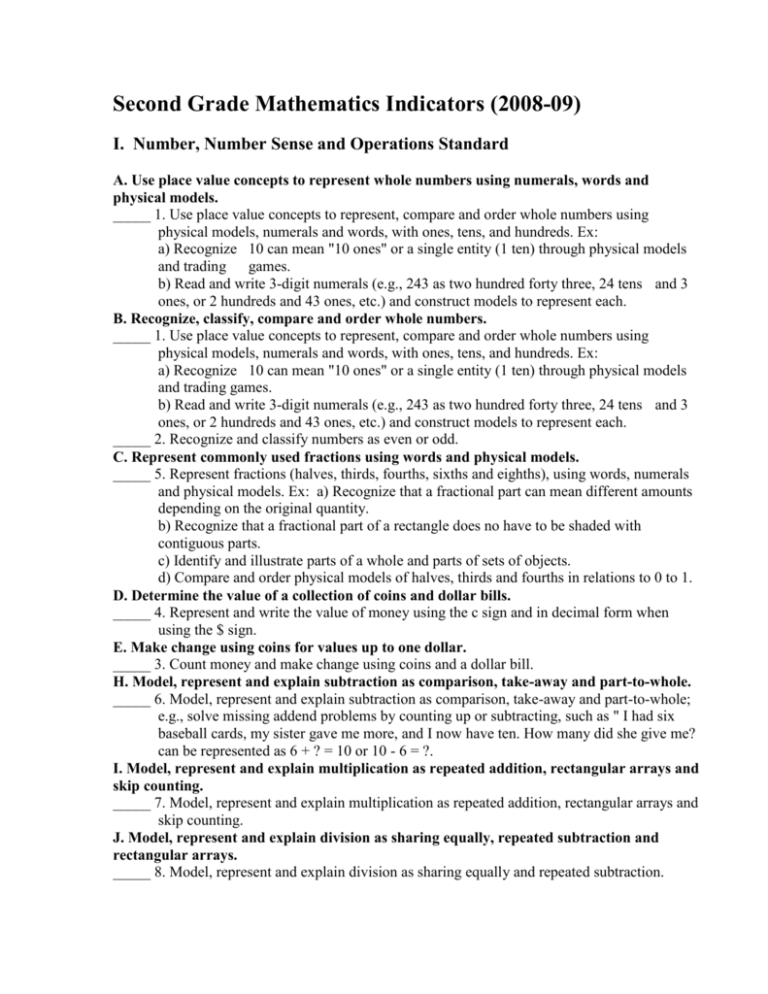
Second Grade Mathematics Indicators (2008-09) I. Number, Number Sense and Operations Standard A. Use place value concepts to represent whole numbers using numerals, words and physical models. _____ 1. Use place value concepts to represent, compare and order whole numbers using physical models, numerals and words, with ones, tens, and hundreds. Ex: a) Recognize 10 can mean "10 ones" or a single entity (1 ten) through physical models and trading games. b) Read and write 3-digit numerals (e.g., 243 as two hundred forty three, 24 tens and 3 ones, or 2 hundreds and 43 ones, etc.) and construct models to represent each. B. Recognize, classify, compare and order whole numbers. _____ 1. Use place value concepts to represent, compare and order whole numbers using physical models, numerals and words, with ones, tens, and hundreds. Ex: a) Recognize 10 can mean "10 ones" or a single entity (1 ten) through physical models and trading games. b) Read and write 3-digit numerals (e.g., 243 as two hundred forty three, 24 tens and 3 ones, or 2 hundreds and 43 ones, etc.) and construct models to represent each. _____ 2. Recognize and classify numbers as even or odd. C. Represent commonly used fractions using words and physical models. _____ 5. Represent fractions (halves, thirds, fourths, sixths and eighths), using words, numerals and physical models. Ex: a) Recognize that a fractional part can mean different amounts depending on the original quantity. b) Recognize that a fractional part of a rectangle does no have to be shaded with contiguous parts. c) Identify and illustrate parts of a whole and parts of sets of objects. d) Compare and order physical models of halves, thirds and fourths in relations to 0 to 1. D. Determine the value of a collection of coins and dollar bills. _____ 4. Represent and write the value of money using the c sign and in decimal form when using the $ sign. E. Make change using coins for values up to one dollar. _____ 3. Count money and make change using coins and a dollar bill. H. Model, represent and explain subtraction as comparison, take-away and part-to-whole. _____ 6. Model, represent and explain subtraction as comparison, take-away and part-to-whole; e.g., solve missing addend problems by counting up or subtracting, such as " I had six baseball cards, my sister gave me more, and I now have ten. How many did she give me? can be represented as 6 + ? = 10 or 10 - 6 = ?. I. Model, represent and explain multiplication as repeated addition, rectangular arrays and skip counting. _____ 7. Model, represent and explain multiplication as repeated addition, rectangular arrays and skip counting. J. Model, represent and explain division as sharing equally, repeated subtraction and rectangular arrays. _____ 8. Model, represent and explain division as sharing equally and repeated subtraction. K. Demonstrate fluency in addition facts with addends through 9 and corresponding subtraction. _____ 10. Demonstrate fluency in addition facts with addends through 9 and corresponding subtractions; e.g., 9 + 9 = 18, 18 - 9 = 9. .L. Demonstrate fluency in adding and subtracting multiples of 10, and recognize combinations that make 10. _____ 11. Add and subtract multiples of 10. M. Demonstrate fluency in adding and subtracting multiples of 10, and recognize combinations that make 10. _____ 9. Model and use the commutative property for addition _____ 12. Demonstrate multiple strategies for adding and subtracting 2- or 3-digit whole numbers, such as: a) compatible numbers; b) compensatory numbers; c) informal use of commutative and associative properties of addition. II. Measurement Standard B. Select appropriate units for length, weight, volume (capacity) and time, using: • Objects; i.e., non-standard units; • U.S. customary units: inch, foot, yard, ounce, pound, cup, quart, gallon, minute, hour, day, week and year; _____ 1. Identify and select appropriate units of measure for: a) length - centimeters, meters, inches, feet or yards; b) volume (capacity) - liters, cups, pints or quarts; c) weight - grams, ounces or pounds; d) time - hours, half-hours, quarter hours or minutes and time designations, a.m. or p.m. C. Develop common referents for units of measure for length, weight, volume (capacity) and time to make comparisons and estimates. _____ 2. Establish personal or common referents for units of measure to make estimates and comparisons; e.g., the width of a finger is a centimeter, a large bottle of soda pop is 2 liters, a small paper clip weighs about one gram. _____ 4. Tell time to the nearest minute interval on digital and to the nearest 5 minute interval on analog (dial) timepieces. D. Apply measurement techniques to measure lengths, weigh and volume (capacity). _____ 5. Estimate and measure the length and weight of common objects, using metric and U.S. customary units, accurate to the nearest unit. _____ 6. Select and use appropriate measurement tools; e.g., a ruler to draw a segment 3 inches long, a measuring cup to place 2 cups of rice in a bowl, a scale to weigh 50 grams of candy. E. Recognize that using different units of measurement will yield different numbers for the same measurement. _____ 3. Describe and compare the relationships among units of measure, such as centimeters and meters; inches, feet and yards; cups, pints and quarts; ounces and pounds; and hours, half-hours, and quarter-hours; e.g., how many inches in a foot? _____ 7. Make and test predictions about measurements, using different units to measure the same length or volume. III. Geometry and Spatial Sense Standard A. Describe and create plan figures: circle, rectangle, square, triangle, hexagon, trapezoid, parallelogram and rhombus, and identify them in the environment. _____ 1. Identify, describe, compare and sort three-dimensional objects i.e., cubes, spheres, prisms, cones, cylinders and pyramids) according to the shape of the faces or the numbers of faces, edges or vertices. _____ 2. Predict what new shapes will be formed by combining or cutting apart existing shapes. B. Describe solid objects: cube, rectangular prism, sphere, cylinder, cone and pyramid, and identify them in the environment. _____ 1. Identify, describe, compare and sort three-dimensional objects i.e., cubes, spheres, prisms, cones, cylinders and pyramids) according to the shape of the faces or the numbers of faces, edges or vertices. C. Sort and compare two-dimensional figures and three-dimensional objects according to their characteristics and properties. _____ 1. Identify, describe, compare and sort three-dimensional objects i.e., cubes, spheres, prisms, cones, cylinders and pyramids) according to the shape of the faces or the numbers of faces, edges or vertices. D. Identify, explain and model (superposition, copying) the concept of shapes being congruent and similar. _____ 4. Identify and determine whether two-dimensional shapes are congruent (same shape and size) or similar (same shape different size) by copying or using superposition (lay one thing on top of another). E. Recognize two- and three-dimensional objects from different positions. _____ 3. Recognize two-dimensional shapes and three-dimensional objects from different positions. G. Identify and draw figures with line symmetry. _____ 5. Create and identify two-dimensional figures with line symmetry; e.g., what letter shapes, logos, polygons are symmetrical? IV. Patterns, Functions and Algebra Standard B. Extend sequences of sounds and shapes or simple number patterns, and create and record similar patterns. _____ 1. Extend simple number patterns (both repeating and growing patterns), and create similar patterns using different objects, such as using physical materials or shapes to represent numerical patterns. C. Create and extend patterns: and describe the rule in words. _____ 2. Use patterns to make generalizations and predictions; e.g., determine a missing element in pattern. _____ 3. Create new patterns with consistent rules or plans, and describe the rule or general plan of existing patterns. D. Model problem situations using objects, pictures, numbers and other symbols. _____ 4. Use objects, pictures, numbers and other symbols to represent a problem situation. E. Solve open sentences and explain strategies. F. Represent and unknown quantity as a variable using a symbol, such as m, n _____ 6. Use symbols to represent unknown quantities and identify values for symbols in an expression or equation using addition and subtraction; e.g., + = 10, - 2 = 4. G. Describe and compare qualitative and quantitative changes. _____ 7. Describe quantitative and quantitative changes especially those involving addition and subtraction; e.g., a student growing taller versus a student growing two inches in one year. V. Data Analysis and Probability Standard A. Pose questions and gather data about everyday situations and familiar objects. _____ 1. Pose questions, use observations, interviews and surveys to collect data, and organize data in charts, picture graphs and bar graphs. _____ 6. Recognize that data may vary from one population to another; e.g., favorite TV shows of students and of parents B. Sort and classify objects by attributes, and organize data into categories in a simple table or chart. _____ 1. Pose questions, use observations, interviews and surveys to collect data, and organize data in charts, picture graphs and bar graphs. _____ 4. Write a few sentences to describe and compare categories of data represented in a chart or graph, and make statements about the data as a whole. C. Represent data using objects, picture graphs and bar graphs. _____ 2. Read, interpret and make comparisons and predictions from data represented in charts, line plots, picture graphs and bar graphs. _____ 3. Read and construct simple timelines to sequence events. _____ 5. Identify untrue or inappropriate statements about a given set of data. D. Describe the probability of chance events as more, less or equally likely to occur. _____ 7. List some of the possible outcomes of a simple experiment, and predict whether given outcomes are more, less or equally likely to occur. _____ 8. Use physical models and pictures to represent possible arrangements of 2 or 3 objects.

